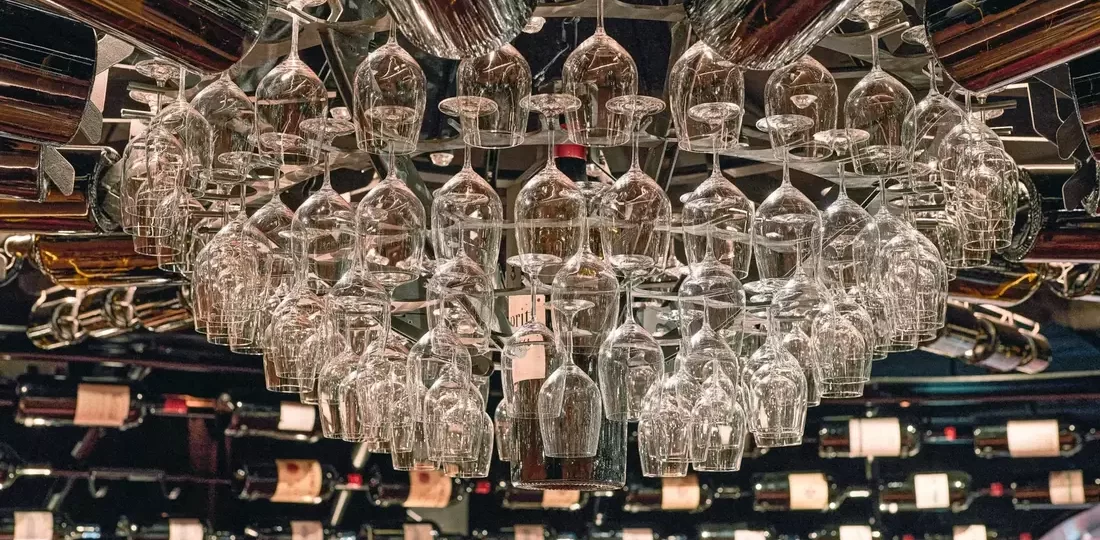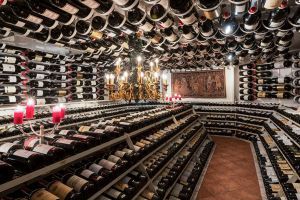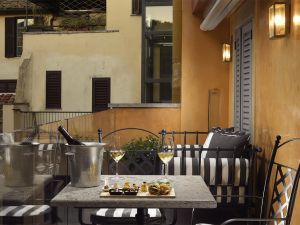
ARLBERG: Where History and Wine Ascend to Rarefied Heights
At the pinnacle of the treacherous Arlberg Pass sits a sanctuary for skiers, hikers and wine buffs alike. At 1,800 metres above sea level, Adi Werner—pioneer of alpine tourism—has built one of the best cellars on the planet. No self-respecting oenophile can afford to skip a pilgrimage to his door.
Adi has hospitality in his bones. He inherited a restaurant from his parents and swiftly decided to add a hotel. The Hospiz was born in 1988 on a site traditionally associated with saving lives—a tradition stretching back 600 years, when a pig herder and his servant began rescuing travellers from winter deaths in the snow.
Today, Adi Werner is president of the Brotherhood of St Christoph, patron saint of travellers. The charity now focuses on alleviating poverty. Distinguished guests are invited to become brothers and sisters of the Brotherhood. I unexpectedly witnessed an induction ceremony while staying there—Adi swinging his sword down on new members’ shoulders. The trick being for neither to fall over.
The skiing in Arlberg is wonderful. In the 1980s, it was a closely guarded secret, a place where royalty could slip in and out unnoticed. The real measure of its hospitality, however, is that those without fame or fortune are equally welcome.
As you enter, photographs of duchesses, royals, politicians, actors, and famous CEOs adorn the entry corridor. Brotherhood members include the Dutch royal family, Norway’s King and Queen, and skiing legend Franz Klammer. King Charles is reportedly under consideration.
The Wine Cellar
The Hospiz Weinkeller houses an extraordinary collection of large-format bottles: Impériale, Melchior, Balthazar, Salmanazar, and Nebuchadnezzar. With over 7,000 large-format bottles, imperials of Château Margaux and Cheval Blanc adorn the cellar walls. The collection spans three centuries, with an 1858 Château d’Yquem marking the start of the timeline.
Werner’s journey to Bordeaux initially met with scepticism. He chuckles about being turned away as “the man from the mountain.” Everything changed when Thierry and Marie-France Manoncourt of Château Figeac hosted him. Manoncourt introduced Werner to oversized bottles, showing him magnums from the 1800s and explaining they were originally produced for Russian Tsars before falling out of favour after revolution and war.
Werner seized his opportunity to stand out among other collectors. Today, he maintains relationships with more than 40 prestigious French châteaux and can request almost any size bottle. Some houses, including Cheval Blanc, now send their large formats exclusively to the Hospiz.
These enormous bottles aren’t just for show. Wine matures more slowly in larger formats, enhancing flavour over time. As one sommelier explains, “If you’re a group all enjoying a great wine, it will always taste better from a bigger bottle. The taste is far more consistent from a 12-litre bottle than from 15 single bottles.”
Recently, the Werner family partnered with real estate investor Sorovia to create an architectural dome showcasing their expanding collection, complementing the main cellar in the Hospiz. The Dome is one of the most spectacular architectural projects in the country.
A Few Facts About the Hospiz Alm Wine Cellar:
Oldest Bottle: Château d’Yquem from 1865
Also houses a Château Yquem 1921
Most Expensive Bottle: 12-litre Cheval Blanc (€65,000)
Most Popular Large Format Wines: Cheval Blanc 1982 Magnum and Petrus 1990
ROME: Hotel Dè Ricci
“A glass of good wine is a gracious creature, and reconciles poor mortality to itself—and that is what few things can do.” — Walter Scott
Hotel Dè Ricci shines brightest when it comes to wine. As Rome’s first wine hotel, its cellar holds over 1,500 labels and more than 10,000 bottles—declared by Wine Spectator as Rome’s best collection for four consecutive years.
Guests enjoy cellar tours and can purchase bottles directly. Each of the eight immaculately designed suites features a private in-suite wine cellar with eight bottles—sparkling, white, and red—curated by in-house sommeliers to suit guest preferences.
Check-in includes a welcome glass of Franciacorta or Champagne before guests discover their curated bottles, wine list, Riedel glasses and corkscrew. Private tastings can be arranged in-room or at the bar. Head sommelier Flavio Scannavino also arranges exclusive winery visits across Italy.
The suites blend elegance with playful vintage touches and custom frescoes by illustrator Andrea Ferolla. Four suites have private terraces, perfect for sipping wine in the warmer months. Lorenzo Lisi, owner of nearby seafood restaurant Pierluigi, is the visionary behind this vinous haven.
SOUTH AFRICA: Pinotage Finds Its Voice
“If your dreams don’t make you afraid, then they’re not big enough,” declares Wynand Lategan, Lanzerac’s winemaker—with the confidence of a man who knows his Pinotage won’t give you a hangover (unless you drink the whole bottle).
The story of Lanzerac and Pinotage reads like a classic underdog tale—with tannins. When they released the world’s first commercial Pinotage in 1961, they weren’t just launching a wine; they were planting South Africa’s flag in a rather snooty wine world.
Pinotage—the love child of Pinot Noir and Cinsault (then called Hermitage)—was created in 1925 by Professor Abraham Izak Perold at Stellenbosch University. His goal: combine Burgundy’s noble character with South Africa’s tough growing conditions.
The professor never saw his creation flourish. The journey from lab to legend was tortuous, its success as unlikely as a penguin winning MasterChef. When Lanzerac finally bottled it in 1959, critics noted hints of banana and acetone—reminiscent, some thought, of nail polish remover. Lesser estates might have given up. Lanzerac did not.
Today, their Pinotage is refined and confident, with complex dark fruit flavours, subtle spice, and impressive ageing potential.
A Storied History
But this is just one chapter in Lanzerac’s long story, stretching back to 1692. Nestled in the Jonkershoek Valley outside Stellenbosch, it was the third-oldest farm in the region. First owned by Isaac Schrijver, he named it Schoongezicht (“wonderful view”).
In the early 1800s, the first cellar was built, later joined by the iconic Manor House with its Cape Dutch architecture—all gables and whitewash, like a wedding cake designed by an art historian. The estate got its French name from Elizabeth Catherina ‘Kitty’ English, rumoured to be fascinated by General Charles Lanrezac.
In 1959, Lanzerac’s owners added a hotel, embracing the French tradition of pairing wine with hospitality. Visitors have included King George V, Nelson Mandela and Senator Bobby Kennedy. British tourists, fond of the estate’s “shabby chic” charm, earned the nickname “the swallows” for their annual winter migration.
After a devastating fire in 2017, Lanzerac has entered a bold new chapter under the Rawson family, with designer Con van der Colff breathing new life into this grande dame.
ENGLAND: The PIG Revolution in Wine Culture
From South Africa to southern England, dreams are fuelling a quiet wine revolution. Once a bystander, the UK is now scooping up global awards and commanding serious attention.
“English wine is improving all the time. The best English sparkling can easily match Champagne for quality and flavour.” — Robin Hutson
The PIG hotels—created by Robin Hutson and his wife Judy—have grown from a single Brockenhurst property into a collection of nine boutique hotels. The South Downs site now features a vineyard where 4,000 vines of Chardonnay, Pinot Noir, Pinot Meunier and experimental Gamay grow.
Robin’s wine journey began when he co-founded Hotel du Vin in the 1980s with Frenchman Gérard Basset, a Master Sommelier and Master of Wine. Their playful but expert approach shaped The PIG’s wine identity.
Their lists categorise top-tier bottles as “Rockstars,” lesser-known finds as “Curiosities,” and classics as “Archetypal.”
More Than a Toe in Wine
The Hutsons have moved beyond appreciation to direct investment in British vineyards. Their longest-standing collaboration is with winemakers Dermot and Ana Sugrue. Their wines? Fantastic. Their names? Delightfully cheeky.
Expect labels like “The Trouble with Dreams,” “ZODO,” “Rosé Ex Machina,” and my personal favourite, “Bonkers.” It’s wine with a wink—without compromising quality.
The Flowering of the UK’s Wine Garden
The name “The Trouble with Dreams” was inspired by a near disaster: Sugrue’s first Chardonnay harvest was decimated by birds the night before picking. “Someone said, ‘that’s the trouble with dreams.’ The name stuck.”
Each PIG hotel can direct guests to nearby winemakers, many of whom supply the hotel. Gusbourne Estate is a standout. Several properties offer tastings and seasonal lunches.
Though the Hutsons stepped down after 14 years, their impact is lasting. They’ve redefined English hospitality—and put English wines firmly on the global stage.
TURKEY: Uncorking Ancient Traditions
“A lot of the wines getting international recognition are from small wineries. They’re winning awards, gaining traction in North America—and ending up on menus in high-end restaurants.” — Turgay Tümüş, Buradan Winery
Turkish wines are making their way onto some of the best wine lists in the world. Unlike overexposed European regions, Turkey offers a sense of wine discovery. You’re not just sipping—you’re pioneering.
Christopher Vannoy has emerged as a key voice in this renaissance. With over 20 years immersed in Turkish wine, he blends technical knowledge with deep cultural insight.
Originally from the US, Vannoy settled in a nomadic village near Antalya. His Georgia Tech engineering roots meet his love for the land in a thoughtful, curious approach to wine.
Turkey on the Rise
Turkey’s wine laws make tasting trickier than in Europe. For example, tastings must occur in licensed restaurants—not cellars. Since 2013, advertising has been banned under the current government.
For these reasons, guided tours—like those offered by Vannoy—are a smart option. His website (turkish-wine.com) and custom tours open up overlooked regions and wines, from Istanbul day trips to seven-day journeys across the country.
With over 400 reviews and a deep appreciation of Eastern traditions and Western palates, Vannoy helps travellers uncover one of the most exciting and ancient frontiers in winemaking.



